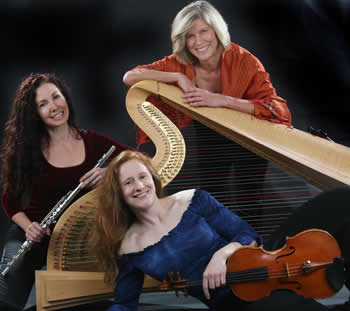The North Carolina Museum of Art was graced with the presence of the Fire Pink Trio on a warm spring-like afternoon. The trio is made up of three professional, accomplished, and widely honored women, a blond, a brunette, and one with auburn locks. Now if you want to make something of this, you can; however their name comes from “the beautiful North Carolina wildflower that covers the mountains in late Spring [-] Fire Pinks resemble the strokes of a painter’s brush, symbol[s] of creativity and fresh, new ideas to the members of the trio.” The trio consists of Jacquelyn Bartlett, harp, Sheila Browne, viola, and Debra Reuter-Pivetta, flute. Their concert, entitled “American Reflections: The Human Experience,” was presented on the Sights and Sounds on Sundays series in conjunction with the museum exhibition, “Bob Trotman: Inverted Utopias.”
Actor-musician Sonny Burnette has been involved with the entertainment industry his entire professional life, and his piece, “Crusin’ with the Top Down,” provided just what the title suggests: a light and airy flight of fancy. A little Hollywood influence and a jazz riff ending topped off the opener and provided the trio with an opportunity to familiarize the audience with the lush and melodic capabilities of this combination of instruments.
This was followed by Wake Forest University Composer-in-Residence Dan Locklair’s Dreamsteps – A Dance Suite for Flute, Viola and Harp. Composed for and premiered in 1993 by the Mallarmé Chamber Players, it has since been performed widely and recorded twice.
Locklair has developed a style that uses contemporary compositional language to communicate comfortably with all audiences. In brief remarks, the composer explained that Dreamsteps was inspired by the poetry of Langston Hughes. The first movement, “Barcaroles and Recitatives,” introduces the piece with a quiet and gentle dreamlike sequence that leads into moments of frustration. The second movement, “Awakenings,” is upbeat and vibrant using a Lutheran Advent hymn as thematic material. “Bars of Blues,” the third movement, projects a hint of mysticism while weaving development around the well-known spiritual “Nobody Knows the Trouble I’ve Seen.” The fourth section, “Ballade in Sarabande,” uses another spiritual, “Balm in Gilead,” as an undercurrent and expresses longing and struggle. The harpist interjects a drum rhythm by striking the soundboard of her instrument. A return to the opening “Barcaroles” develops the dreamlike element further, and the work ends with a wistful sense of longing. Dreamsteps is a well-balanced and satisfying listening experience as the audience’s vigorous and extended applause confirmed.
Next we heard from a very worthy but not widely known American composer. Adolphus Hailstork was born in Rochester, NY. He received a master’s degree from the Manhattan School of Music and a doctorate in composition from Michigan State University in 1971. He has also studied composition with such renowned instructors as Vittorio Giannini, David Diamond, and Nadia Boulanger. He was awarded a Fullbright fellowship in 1987 and is currently a professor of music and Composer-in-Residence at Old Dominion University in Norfolk, Virginia. Hailstork is of African-American ancestry, and his works blend musical ideas from both the African-American and European traditions.
As Falling Leaves is a visceral and moving musical documentary of the events of 9/11/2001. The five movements are played without pause using a variety of unusual techniques including flutter-tongue on flute and slapping the strings of the harp. The composer wrote these words about the piece: “They did not commit suicide; they were already dead – and they knew it. That was my first thought when I heard about the people who, when trapped on the upper floors of the World Trade Center on September the eleventh, two thousand and one, chose to leap to their death rather than to be incinerated in the two thousand degree inferno surrounding them. It was a final life choice. In this composition, actually a tone poem for flute, viola and harp, I wanted to reflect the thoughts of a person facing that gruesome choice. The leap into space is the final dance.” (Taken from http://chevalierdesaintgeorges.homestead.com/hailstork.html, where there is lots more about Hailstork and his music.)
The music was heart wrenching, gruesome, peaceful, awful, awesome, and much more, ulimately pointing toward resolution. It was at the start painful to hear, recalling the horror experienced by those of us who watched in unbelieving fascination on that fateful day. It internalized what we merely watched. It left me stunned and emotionally drained and not knowing quite what to do. Apparently the audience experienced something of the same thing. After several moments of silence, someone chose to applaud and the return to the here and now was accomplished as others – perhaps all – joined in. In reflection, maybe audiences should be warned of what they may experience when hearing this music. It was a powerful demonstration of the ability of the medium of music, artistically conceived by Hailstork and stunningly performed by the Fire Pink Trio.
The closing selection eased the audience back toward present reality with a tango by composer and music publisher Christopher Caliendo. “Tristeza” is the Spanish and Portuguese word for sadness. This piece has been widely performed by groups of divergent styles using instruments including guitar, voice, clarinet, and others. The arrangement for flute, viola, and harp conveyed the sadness of lost love in a lilting, rhythmically sweet melody. Perhaps it was to remind us that in a world of sadness the expression of unrequited longing is a universal one and in spite of that, we go on, loving again, surviving, and experiencing life in its full range of riches.
The Fire Pink Trio provided us with an afternoon filled with life’s experiences communicated musically with extraordinary skill and sensitivity. Thanks to the Raleigh Chamber Music Guild.












